Changing and Unchanging Things: Noguchi and Hasegawa in Postwar Japan
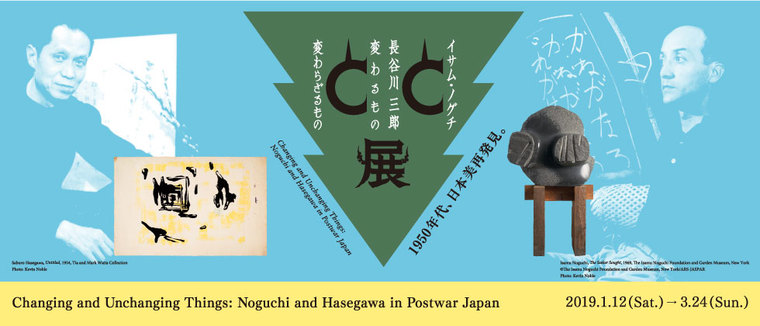
Overview
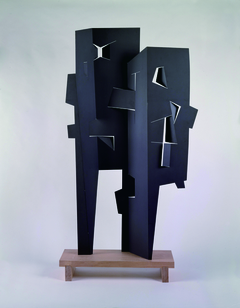
Isamu NOGUCHI,
”Noh Musicians,” 1958,
aluminum, paint, 178.4×99.1×19.7cm,
The Isamu Noguchi Foundation and Garden Museum, New York
©The Isamu Noguchi Foundation and Garden Museum, New York/ARS–JASPAR
Photo: Kevin Noble
Sculptor Isamu Noguchi (1904-1988), of Japanese and American ancestry, sought to reintegrate art into people’s daily lives, as it was in the prehistoric or ancient remains he saw in his travels through Europe and Asia since 1949, while Saburo Hasegawa (1906-1957) was a leading figure in Japanese prewar abstraction as a painter, and as a theorist he studied Western modern art movements and the traditional arts of Japan, finding aspects common to both in abstract art. In May 1950 Noguchi set foot on Japanese soil, as the final destination of his travels, for the first time in 19 years, and had a fateful encounter with Hasegawa, who had known Noguchi’s work since 1948 and was so eager for dialogue that he planned to establish correspondence with the sculptor. They found astounding similarities and a powerful resonance between their shared interests and respective visions.
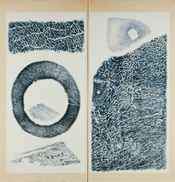
Saburo HASEGAWA,
”Nature,”
1953,
two-panel folding screen, ink on paper, each 135.0×66.5cm,
The National Museum of Modern Art, Kyoto
*On exhibit:January 12 (Sat.)- February 13 (Wed.), 2019
This exhibition focuses on the friendship between these two artists, exploring what they saw, thought about, and aspired to do, through approximately 50 works by Noguchi and 70 by Hasegawa, particularly from the years of their association in the 1950s.
*Some works will be replaced with others while the exhibition is on view, for conservation purposes.
What Noguchi and Hasegawa Sought: Synthesis of “the Old East and the New West”
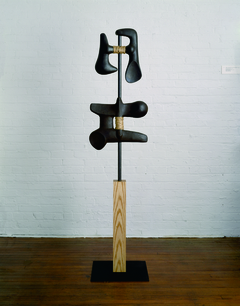
Isamu NOGUCHI,
”Calligraphics,” 1957,
iron, wood, rope, metal,
178.8×43.5×40.6cm,
The Isamu Noguchi Foundation and Garden Museum, New York
©The Isamu Noguchi Foundation and Garden Museum, New York/ARS-JASPAR
Photo: Kevin Noble
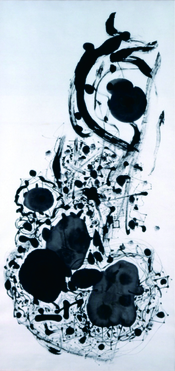
Saburo HASEGAWA,
”Untitled,” 1954,
ink on paper, 138.8×70.0cm,
KONAN GAKUEN Saburo Hasegawa Memorial Gallery
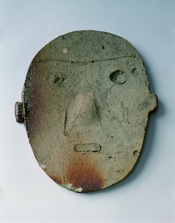
Isamu NOGUCHI,
”Face Dish,”
1952,
ceramic, 30.8×27.3×2.9cm,
The Isamu Noguchi Foundation and Garden Museum, New York
©The Isamu Noguchi Foundation and Garden Museum, New York/ARS-JASPAR
Photo: Kevin Noble
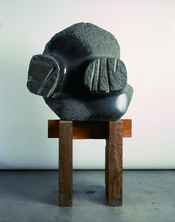
Isamu NOGUCHI,
”The Seeker Sought,”
1969,
basalt, 94.0×100.3×49.8cm,
The Isamu Noguchi Foundation and Garden Museum, New York
©The Isamu Noguchi Foundation and Garden Museum, New York/ARS-JASPAR
Photo: Kevin Noble
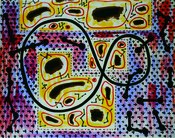
Saburo HASEGAWA,
”Locus of a Butterfly,”
1937,
oil on canvas, 130.0×161.5cm,
The National Museum of Modern Art, Kyoto
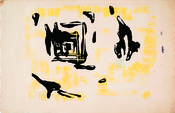
Saburo HASEGAWA,
Untitled,
1954,
ink on paper, 33.5×51.2cm,
Tia and Mark Watts Collection
Photo: Kevin Noble
Highlights
- Many of Noguchi’s and Hasegawa’s most admired works, as well as many never shown in Japan before!
In addition to many of Hasegawa’s best-known sumi ink works, prints, and rubbings from the collections of Japanese national and public museums, this exhibition features “Garden Elements” (1958), one of Noguchi’s most important stone sculptures, made in Japan, exhibited in the US, and then never seen in public for many years, as well as many pieces exhibited in Japan for the first time, including sumi ink paintings, photograms and other previously unknown works produced by Hasegawa after he moved to the US.
Through about 120 works – paintings, sculptures, prints, photographs, calligraphy and more – this exhibition traces both the creative trajectories and the deeply fruitful friendship of Noguchi and Hasegawa.
*Before this exhibition, Isamu Noguchi’s “Garden Elements” (1958) is scheduled for display in the Grand Gallery of the Yokohama Museum of Art starting in late November 2018. - Exhibition held jointly in the US and Japan. Some works will be shown only in Yokohama!
This exhibition was jointly organized by the Isamu Noguchi Foundation and Garden Museum, New York and the Yokohama Museum of Art.
Most of the featured works will travel to the Noguchi Museum (New York) and the Asian Art Museum (San Francisco) after being shown in Yokohama. In addition to these, the Yokohama Museum of Art will exclusively exhibit several works, including prewar abstractions and photos such as the painting “Locus of a Butterfly” (1937), that illustrate Saburo Hasegawa’s role as a pioneer of Japanese abstract art.
Also on view will be Noguchi’s plaster model for his proposed “Memorial to the Dead of Hiroshima” (1951-52), only shown to the public in recent years, alongside Noguchi works from the Yokohama Museum of Art collection.
Biography
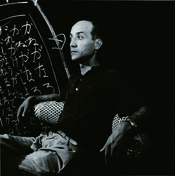
Isamu NOGUCHI, 1950
Photo: Jun Miki
Photo courtesy of The Isamu Noguchi Foundation and Garden Museum, New York
Isamu Noguchi was born in Los Angeles as the son of Japanese poet Noguchi Yonejiro and American writer and teacher Leonie Gilmour. His earliest years were spent in Japan but he was sent back to the United States at the age of thirteen. When he set his mind on becoming a sculptor, he had the opportunity to apprentice with Brancusi. In 1929, he moved to New York and based his activities there. He made his living with portrait busts, but at the same time produced abstract sculpture and did public park planning, stage set design, and other projects. He returned to Japan in 1931, after a gap of 13 years, and visited Kyoto and Nara. During World War II, he voluntarily entered a relocation camp for Japanese Americans. There he planned landscape designs for park and other areas inside the campgrounds. He traveled to Europe and Asia in 1949, in search of connections between art and society in earlier ages, and arrived in Japan, his final destination, in 1950. Noguchi met Hasegawa Saburo and explored cultural heritage sites together with him. He began designs for the Hiroshima Peace Bridge railings (completed in 1952) and for a memorial (unrealized) for atomic bomb victims. Noguchi’s understanding of traditional Japanese aesthetics was deepened through his dialogue with Hasegawa on subjects such as Zen, Japanese tea ceremony, calligraphy, etc., that greatly influenced his thought and the subsequent development of his art.
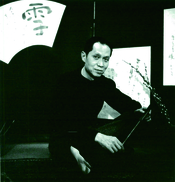
Saburo HASEGAWA, ca. 1956 Photo courtesy of KONAN GAKUEN Saburo Hasegawa Memorial Gallery
Hasegawa Saburo studied oil painting under Koide Narashige when he was a student at Konan High School. He went on to major in art history at Tokyo Imperial University and quickly became versed in both art technique and theory. Studying art in Europe for three years, starting from 1929, he made up his mind to devote himself to painting. He started creating abstract oil paintings in 1936 and was among the founders of the Association of Free Artists (Jiyu Bijutsuka Kyokai). He also produced photographic works from the time of the beginning of the Second Sino-Japanese War (1937) until the end of World War II (1945). With increasingly severe suppression of speech and expression, he turned to studies of haiku, Zen, and tea ceremony. After the war, he resumed his activities as a painter with the Modern Artists Association of Nippon, founded in 1947. Meeting Isamu Noguchi in 1950 and traveling together with Noguchi in Kansai region, Hasegawa gained confidence in his long-held premise of a relationship between Abstract Art and traditional Japanese aesthetics. He shifted from oil painting to rubbings and ink painting. In 1954 he was warmly welcomed in New York, in the midst of a ‘Japan boom’ at the time. After briefly returning to Japan, he moved to San Francisco where he had an appointment as a professor and significantly influenced young artists until he passed away in 1957.
Outline
| Dates | January 12 (Sat.)- March 24 (Sun.), 2019 |
|---|---|
| Open Hours | 10:00-18:00 *Open until 20:30 on March 2 (Sat.), 2019 *Admission until 30 minutes before closing. |
| Closed | Thursdays(Except March 21), March 22, 2019 |
| Organized by | Yokohama Museum of Art (Yokohama Arts Foundation), The Isamu Noguchi Foundation and Garden Museum, New York, Kanagawa Shimbun, Television Kanagawa Inc. |
| Supported by | Embassy of the United States of America in Japan |
| Grant from | Terra Foundation for American Art |
| In Special Cooperation with | ALL NIPPON AIRWAYS CO., LTD. |
| In Cooperation with | Yokohama FM Broadcasting Co., Ltd., Metropolitan Expressway Co., Ltd., NIKON CORPORATION, NIKON IMAGING JAPAN INC., Minatomirai Line, Yokohama Cable Vision Inc. |
Ticket
| Adults | 1,500(¥1,300/1,400) |
|---|---|
| University students High school students | 900 (700/800) |
| Junior high school students | 600 (400/500) |
| Children under 12 | Free |
| Seniors (65 and older) | 1,400 *ID required. Only available at ticket counter in the museum. |
| Advance Pair Tickets | 2,000 *A pair of tickets for two people. *On sale from September 1 (Sat.) until November 11 (Sun.), 2018 |
*(/)=Advance / Group of 20 or more.
*For a group of 20 or more, reservation is required in advance.
*Advance tickets are available from November 12 (Mon.) ,2018 until January 11 (Fri.), 2019 at the Museum Shop and through Seven-Eleven ticket or eplus ticket.
*Free Admission on February 24(Sun.)
*Free admission for high school students and younger with valid IDs on Saturdays.
*Visitors with disability and one person accompanying them are admitted free of charge. (Please present certificate at the entrance.)
*The ticket also gives admission to the Exhibition of the Museum Collection for the same day.
■Valentine's Pair Tickets:¥2,500
*A pair of tickets for two people.
*On sale from February 8 (Fri.) until February 20 (Wed.), 2019
*Only available at ticket counter in the museum.
Event
Changing and Unchanging Things—Noguchi and Hasegawa in the 1950s: Lectures by Curators
| Date | Sunday, January 13, 2019 |
|---|---|
| Time | 13:30-16:00(Doors Open at 13:00) |
| Speakers | Matthew Kirsch (Curator, The Noguchi Museum) Mark Dean Johnson (Professor of Art, San Francisco State University) Naoaki Nakamura (Senior Curator, Yokohama Museum of Art) *Japanese-English consecutive interpretation available |
| Venue | Lecture Hall, Yokohama Museum of Art |
| Capacity | 220 seats (Pre-registration necessary / First-come, first-served basis) |
| Admission | Free |
| Pre-registration | Pre-registration will be possible from 10:00, December 15 (Sat.), 2018. Pre-registration ※Please note that only one person can register under a single email address. |
| Deadline for pre-registration | January 12 (Sat.), 2019, 17:00. (The form will be closed after reaching full capacity.) |
Talk in English Exhibition Highlights!

| Date | March 2 (Sat.), 5 (Tue.), 9 (Sat.), 12 (Tue.), 16 (Sat.), 19 (Tue.), 23 (Sat.), 2019 |
|---|---|
| Time | 10:00-15:00 |
| Venue | The Grand Gallery, Yokohama Museum of Art |
| Admission | Free *Reservation not required. *Please inquire at the main information desk. |
Flyer [406KB]









